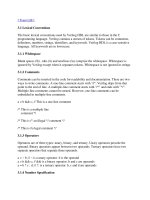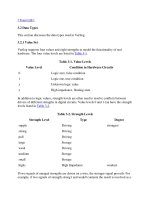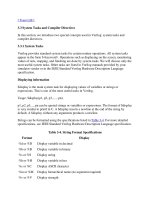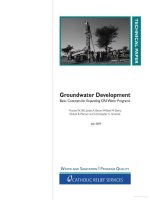Basic concepts
Bạn đang xem bản rút gọn của tài liệu. Xem và tải ngay bản đầy đủ của tài liệu tại đây (73.17 KB, 22 trang )
Chapter 1: Basic Concepts
4
1. BASIC CONCEPTS
Outline
This chapter introduces basic concepts needed for the study and description of morphologically
complex words. Since this is a book about the particular branch of morphology called word-
formation, we will first take a look at the notion of ‘word’. We will then turn to a first analysis of
the kinds of phenomena that fall into the domain of word-formation, before we finally discuss
how word-formation can be distinguished from the other sub-branch of morphology, inflection.
1. What is a word?
It has been estimated that average speakers of a language know from 45,000 to 60,000
words. This means that we as speakers must have stored these words somewhere in
our heads, our so-called mental lexicon. But what exactly is it that we have stored?
What do we mean when we speak of ‘words’?
In non-technical every-day talk, we speak about ‘words’ without ever thinking
that this could be a problematic notion. In this section we will see that, perhaps
contra our first intuitive feeling, the ‘word’ as a linguistic unit deserves some
attention, because it is not as straightforward as one might expect.
If you had to define what a word is, you might first think of the word as a unit
in the writing system, the so-called orthographic word. You could say, for example,
that a word is an uninterrupted string of letters which is preceded by a blank space
and followed either by a blank space or a punctuation mark. At first sight, this looks
like a good definition that can be easily applied, as we can see in the sentence in
example (1):
(1) Linguistics is a fascinating subject.
Chapter 1: Basic Concepts
5
We count 5 orthographic words: there are five uninterrupted strings of letters, all of
which are preceded by a blank space, four of which are also followed by a blank
space, one of which is followed by a period. This count is also in accordance with
our intuitive feeling of what a word is. Even without this somewhat formal and
technical definition, you might want to argue, you could have told that the sentence
in (1) contains five words. However, things are not always as straightforward.
Consider the following example, and try to determine how many words there are:
(2) Benjamin’s girlfriend lives in a high-rise apartment building
Your result depends on a number of assumptions. If you consider apostrophies to be
punctuation marks, Benjamin's constitutes two (orthographic) words. If not,
Benjamin's is one word. If you consider a hyphen a punctuation mark, high-rise is two
(orthographic) words, otherwise it's one (orthographic) word. The last two strings,
apartment building, are easy to classify, they are two (orthographic) words, whereas
girlfriend must be considered one (orthographic) word. However, there are two basic
problems with our orthographic analysis. The first one is that orthography is often
variable. Thus, girlfriend is also attested with the spellings <girl-friend>, and even
<girl friend> (fish brackets are used to indicate spellings, i.e. letters). Such variable
spellings are rather common (cf. word-formation, word formation, and wordformation, all
of them attested), and even where the spelling is conventionalized, similar words are
often spelled differently, as evidenced with grapefruit vs. passion fruit. For our
problem of defining what a word is, such cases are rather annoying. The notion of
what a word is, should, after all, not depend on the fancies of individual writers or
the arbitrariness of the English spelling system. The second problem with the
orthographically defined word is that it may not always coincide with our intuitions.
Thus, most of us would probably agree that girlfriend is a word (i.e. one word) which
consists of two words (girl and friend), a so-called compound. If compounds are one
word, they should be spelled without a blank space separating the elements that
together make up the compound. Unfortunately, this is not the case. The compound
apartment building, for example, has a blank space between apartment and building.
Chapter 1: Basic Concepts
6
To summarize our discussion of purely orthographic criteria of wordhood, we
must say that these criteria are not entirely reliable. Furthermore, a purely
orthographic notion of word would have the disadvantage of implying that illiterate
speakers would have no idea about what a word might be. This is plainly false.
What, might you ask, is responsible for our intuitions about what a word is, if
not the orthography? It has been argued that the word could be defined in four other
ways: in terms of sound structure (i.e. phonologically), in terms of its internal
integrity, in terms of meaning (i.e. semantically), or in terms of sentence structure
(i.e. syntactically). We will discuss each in turn.
You might have thought that the blank spaces in writing reflect pauses in the
spoken language, and that perhaps one could define the word as a unit in speech
surrounded by pauses. However, if you carefully listen to naturally occurring
speech you will realize that speakers do not make pauses before or after each word.
Perhaps we could say that words can be surrounded by potential pauses in speech.
This criterion works much better, but it runs into problems because speakers can and
do make pauses not only between words but also between syllables, for example for
emphasis.
But there is another way of how the sound structure can tell us something
about the nature of the word as a linguistic unit. Think of stress. In many languages
(including English) the word is the unit that is crucial for the occurrence and
distribution of stress. Spoken in isolation, every word can have only one main stress,
as indicated by the acute accents (´) in the data presented in (3) below (note that we
speak of linguistic ‘data’ when we refer to language examples to be analyzed).
(3) cárpenter téxtbook
wáter análysis
féderal sýllable
móther understánd
The main stressed syllable is the syllable which is the most prominent one in a word.
Prominence of a syllable is a function of loudness, pitch and duration, with stressed
syllables being pronounced louder, with higher pitch, or with longer duration than
Chapter 1: Basic Concepts
7
the neighboring syllable(s). Longer words often have additional, weaker stresses, so-
called secondary stresses, which we ignore here for simplicity’s sake. The words in
(4) now show that the phonologically defined word is not always identical with the
orthographically defined word.
(4) Bénjamin's
gírlfriend
apártment building
While apártment building is two orthographic words, it is only one word in terms of
stress behavior. The same would hold for other compounds like trável agency, wéather
forecast, spáce shuttle, etc. We see that in these examples the phonological definition of
‘word‘ comes closer to our intuition of what a word should be.
We have to take into consideration, however, that not all words carry stress.
For example, function words like articles or auxiliaries are usually unstressed (a cár,
the dóg, Máry has a dóg) or even severely reduced (Jane’s in the garden, I’ll be there).
Hence, the stress criterion is not readily applicable to function words and to words
that hang on to other words, so-called clitics (e.g. ‘ve, ‘s, ‘ll).
Let us now consider the integrity criterion, which says that the word is an
indivisible unit into which no intervening material may be inserted. If some
modificational element is added to a word, it must be done at the edges, but never
inside the word. For example, plural endings such as -s in girls, negative elements
such as un- in uncommon or endings that create verbs out of adjectives (such as -ize in
colonialize) never occur inside the word they modify, but are added either before or
after the word. Hence, the impossibility of formations such as *gi-s-rl, *com-un-mon,
*col-ize-onial (note that the asterisk indicates impossible words, i.e. words that are not
formed in accordance with the morphological rules of the language in question).
However, there are some cases in which word integrity is violated. For
example, the plural of son-in-law is not *son-in-laws but sons-in-law. Under the
assumption that son-in-law is one word (i.e. some kind of compound), the plural
ending is inserted inside the word and not at the end. Apart from certain
Chapter 1: Basic Concepts
8
compounds, we can find other words that violate the integrity criterion for words.
For example, in creations like abso-bloody-lutely, the element bloody is inserted inside
the word, and not, as we would expect, at one of the edges. In fact, it is impossible to
add bloody before or after absolutely in order to achieve the same effect. Absolutely
bloody would mean something completely different, and *bloody absolutely seems
utterly strange and, above all, uninterpretable.
We can conclude that there are certain, though marginal counterexamples to
the integrity criterion, but surely these cases should be regarded as the proverbial
exceptions that prove the rule.
The semantic definition of word states that a word expresses a unified
semantic concept. Although this may be true for most words (even for son-in-law,
which is ill-behaved with regard to the integrity criterion), it is not sufficient in order
to differentiate between words and non-words. The simple reason is that not every
unified semantic concept corresponds to one word in a given language. Consider, for
example, the smell of fresh rain in a forest in the fall. Certainly a unified concept, but
we would not consider the smell of fresh rain in a forest in the fall a word. In fact, English
simply has no single word for this concept. A similar problem arises with phrases
like the woman who lives next door. This phrase refers to a particular person and should
therefore be considered as something expressing a unified concept. This concept is
however expressed by more than one word. We learn from this example that
although a word may always express a unified concept, not every unified concept is
expressed by one word. Hence the criterion is not very helpful in distinguishing
between words and larger units that are not words. An additional problem arises
from the notion of ‘unified semantic concept’ itself, which seems to be rather vague.
For example, does the complicated word conventionalization really express a unified
concept? If we paraphrase it as ‘the act or result of making something conventional’,
it is not entirely clear whether this should still be regarded as a ‘unified concept’.
Before taking the semantic definition of word seriously, it would be necessary to
define exactly what ‘unified concept’ means.
This leaves us with the syntactically-oriented criterion of wordhood. Words
are usually considered to be syntactic atoms, i.e. the smallest elements in a sentence.
Words belong to certain syntactic classes (nouns, verbs, adjectives, prepositions etc.),
Chapter 1: Basic Concepts
9
which are called parts of speech, word classes or syntactic categories. The position
in which a given word may occur in a sentence is determined by the syntactic rules
of a language. These rules make reference to words and the class they belong to. For
example, the is said to belong to the class called articles, and there are rules which
determine where in a sentence such words, i.e. articles, may occur (usually before
nouns and their modifiers, as in the big house). We can therefore test whether
something is a word by checking whether it belongs to such a word class. If the item
in question, for example, follows the rules for nouns, it should be a noun, hence a
word. Or consider the fact that only words (and groups of words), but no smaller
units can be moved to a different position in the sentence. For example, in ‘yes/no’
questions, the auxiliary verb does not occur in its usual position but is moved to the
beginning of the sentence (You can read my textbook vs. Can you read my textbook?).
Thus syntactic criteria can help to determine the wordhood of a given entity.
To summarize our discussion of the possible definition of word we can say
that, in spite of the intuitive appeal of the notion of ‘word’, it is sometimes not easy
to decide whether a given string of sounds (or letters) should be regarded as a word
or not. In the treatment above, we have concentrated on the discussion of such
problematic cases. In most cases, however, the stress criterion, the integrity criterion
and the syntactic criteria lead to sufficiently clear results. The properties of words
are summarized in (5):
(5) Properties of words
- words are entities having a part of speech specification
- words are syntactic atoms
- words (usually) have one main stress
- words (usually) are indivisible units (no intervening material possible)
Unfortunately, there is yet another problem with the word word itself, namely its
ambiguity. Thus, even if we have unequivocally decided that a given string is a
word, some insecurity remains about what exactly we refer to when we say things
like
Chapter 1: Basic Concepts
10
Chapter 1: Basic Concepts
11
(6) a. “The word be occurs twice in the sentence.”
b. [D«wãdbi«kãztwaIsInD«sent«ns]
The utterance in (6), given in both its orthographic and its phonetic representation,
can be understood in different ways, it is ambiguous in a number of ways. First,
<be> or the sounds [bi] may refer to the letters or the sounds which they stand for.
Then sentence (6) would, for example, be true for every written sentence in which the
string <BLANK SPACE be BLANK SPACE> occurs twice. Referring to the spoken
equivalent of (6a), represented by the phonetic transcription in (6b), (6) would be
true for any sentence in which the string of sounds [bi] occurs twice. In this case, [bi]
could refer to two different ‘words’, e.g. bee and be. The next possible interpretation is
that in (6) we refer to the grammatically specified form be, i.e. the infinitive,
imperative or subjunctive form of the linking verb BE. Such a grammatically
specified form is called the grammatical word (or morphosyntactic word). Under
this reading, (6) would be true of any sentence containing two infinitive, two
imperative or two subjunctive forms of be, but would not be true of a sentence which
contains any of the forms am, is, are, was, were.
To complicate matters further, even the same form can stand for more than
one different grammatical word. Thus, the word-form be is used for three different
grammatical words, expressing subjunctive infinitive or imperative, respectively.
This brings us to the last possible interpretation, namely that (6) may refer to the
linking verb BE in general, as we would find it in a dictionary entry, abstracting away
from the different word-forms in which the word BE occurs (am, is, are, was, were, be,
been). Under this reading, (6) would be true for any sentence containing any two
word-forms of the linking verb, i.e. am, is, are, was, were, and be. Under this
interpretation, am, is, are, was, were, be and been are regarded as realizations of an
abstract morphological entity. Such abstract entities are called lexemes. Coming back
to our previous example of be and bee, we could now say that BE and BEE are two
different lexemes that simply sound the same (usually small capitals are used when
writing about lexemes). In technical terms, they are homophonous words, or simply
homophones.









